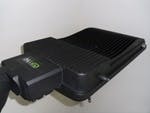Outdoor Lighting: Cree announces new LED street lights; ALSI enhances fixtures
Appalachian Lighting Systems (ALSI) now rates its ALLED outdoor fixtures as capable of withstanding 30 10 kVA surge events making the products more reliable in general and especially suitable for heavy-lightning environments. Cree has announced its latest outdoor solid-state lighting (SSL) luminaire featuring multiple total-internal reflection (TIR) lenses molded into a single optic that offers flexibility in lumen packages and lower costs.
ALSI says that the new driver-electronics package quadruples the ability of its fixtures to withstand power surges. Moreover, the company also announced a new optical light sensor that the company says is more reliable than legacy photo sensors. The combination yields longer life expectancy for the fixtures.
"ALLED fixtures are rated for more than 150,000 hours of operation and are already the industry's most reliable LED fixtures," said COO Rob McAnally. "Even so we wanted to further address external power issues that can wreak havoc with any lights. Bottom line, ALLED lighting will continue to operate through the multiple major surge events that are inevitable in any electrical system."
ALSI also supports wireless network and adaptive controls in its fixtures. The new surge protector can transmit information about surge events to the light owner over a network, allowing the owner to monitor the health of the lights.
The new light sensor is also programmable via a network connection. ALSI says that a light tube replaces the lens used in most legacy cadmium-disulfide photocells. The company says that the new design provides a larger surface area for sensing light conditions enabling finer-grain control. You can see the light tube protruding from the right side of the fixture in the nearby photo.
Cree XSP fixture
Cree Lighting says that the new XSP outdoor fixture offers double the lumens per dollar relative to prior Cree street lights. Vice president and general manager Christopher Ruud said, "The payback of the fixture will be before the first relamp," meaning the time it would take a legacy HID lamp to fail. Ruud said that lowering cost is imperative given that stimulus funds are largely spent in the US.
Payback is dependent both on the initial cost of lighting and energy and maintenance savings. The XSP design addresses both. Ruud said that the fixture offers optical efficiency greater than 90% and system efficacy as high as 100 lm/W. Lower luminaire costs, meanwhile, come through lower-priced and higher-performing LEDs, and the new optics design.
"Capitalizing on innovations in Cree LED chips and components, optic technology and design, and overall luminaire design, the XSP Series exemplifies the best of Cree integrated technology," said Ruud. "The result is the best alternative to traditional street lighting with better payback, better performance, and better pricing, allowing municipalities to focus their resources where it matters most."
New optic design
The optic design builds on technology developed originally by BetaLED called NanoOptic. Cree acquired the BetaLED brand of SSL when it bought Ruud Lighting last year, and is now announcing a technology that it calls NanoOptic Precision Delivery Grid. BetaLED had been a pioneer in TIR optics designed to reliably control SSL beam patterns.
BetaLED's original NanoOptic lenses fit over individual LEDs and have been used in a variety of products including the recently-introduced Cree Aeroblades fixture. The new design molds an array of TIR lenses into a single optic that covers five light sources arranged in an "X" pattern that's visible in the nearby photo.
The new design offers Cree considerable flexibility in delivering many different lumen packages. Luminaire designers can use one or two LEDs under each TIR. And designers can combine two modular LED and optic assemblies in a luminaire.
Ironically, Cree and BetaLED have both said previously that small LEDs offer luminaire designers superior ability to control the light. Indeed Ruud said, "The closer you get to a point source, the better you can control the light." Ruud added that the new design still uses what would be considered a point source, although Cree had to build larger TIR lenses. And Ruud said the aforementioned optical efficiency validates the design. Ruud concluded, "We have achieved better photometric performance than we achieved with NanoOptic in the LEDway products."







